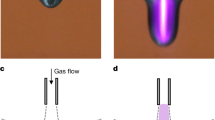Abstract
The operation of microscopic high-speed liquid-metal jets in vacuum has been investigated. We show that such jets may be produced with good stability and collimation at higher speeds than previously demonstrated, provided that the nozzle design is appropriate and that cavitation-induced instabilities are avoided. The experiments with a medium-speed tin jet (u ∼ 60 m/s, Re=1.8×104, Z=2.9×10−3) showed that it operated without any signs of instabilities, whereas the stability of high-speed tin jets (d=30 μm, u=500 m/s, Re=5.6×104, Z=4.7×10−3) has been investigated via dynamic similarity using a water jet. Such a 500-m/s tin jet is required as the anode for high-brightness operation of a novel electron-impact X-ray source.





Similar content being viewed by others
Abbreviations
- a :
-
Nozzle radius
- c 0 :
-
Speed of sound in the jet liquid
- d :
-
Jet diameter after contraction
- d 0 :
-
Nozzle diameter
- L :
-
Jet break-up length
- Ma:
-
Mach number, jet-to-sound speed ratio
- Re:
-
Reynolds number, inertial-to-viscous force ratio
- T :
-
Temperature
- u :
-
Jet speed after contraction
- u 0 :
-
Jet speed at the nozzle exit
- WeA :
-
Atmospheric Weber number, inertial-to-surface tension force ratio for the atmosphere
- WeL :
-
Liquid Weber number, inertial-to-surface tension force ratio for the jet liquid
- Z:
-
Ohnesorge number, viscous-to-surface tension force ratio
- η0 :
-
Initial disturbance amplitude on the jet
- μ:
-
Dynamic viscosity
- ρA :
-
Density of the atmosphere
- ρL :
-
Density of the jet liquid
- σ:
-
Surface tension
References
Alcock CB (2001) Vapor pressure of the metallic elements. In: Lide DR (eds) Handbook of chemistry and physics, 82nd edn, vol 4. CRC Press, New York, pp 4:134–136
Bett KE, Cappi JB (1965) Effect of pressure on the viscosity of water. Nature 207:620–621
Blaisot JB, Adeline S (2003) Instabilities of a free falling jet under an internal flow breakup mode regime. Int J Multiph Flow 29:629–653
Blevins RD (1992) Applied fluid dynamics handbook. Krieger Publishing Company, Malabar
Bogy DB (1979) Drop formation in a circular liquid jet. Annu Rev Fluid Mech 11:207–228
Douglas JF, Gasiorek JM, Swaffield JA (1995) Fluid Mechanics, 3rd edn. Longman Scientific& Technical, Singapore, pp 262–267
Eggers (1997) Nonlinear dynamics and breakup of free surface flows. Rev Mod Phys 69:865–928
Fenn III, RW, Middleman S (1969) Newtonian jet stability: The role of air resistance. AIChE J 15:379–383
Fuchs H, Legge H (1979) Flow of a water jet into vacuum. Acta Astronaut 6:1213–1226
Grant RP, Middleman S (1966) Newtonian jet stability. AIChE J 12:669–678
Hansson BAM, Rymell L, Berglund M, Hertz HM (2000) A liquid-xenon-jet laser-plasma x-ray and EUV source. Microel Engin 53:667–670
Hemberg O, Otendal M, Hertz HM (2003) Liquid-metal-jet anode electron-impact x-ray source. Appl Phys Lett 83:1483–1485
Hemberg O, Otendal M, Hertz HM (2004) Liquid-metal-jet anode x-ray tube. Opt Eng 43:1682–1688
Jansson PAC, Hansson BAM, Hemberg O, Otendal M, Holmberg A, de Groot J, Hertz HM (2004) Liquid-metal-jet laser-plasma extreme ultraviolet generation. Appl Phys Lett 84:2256–2258
Konkachbaev AI, Morley NB, Gulec K, Sketchley T (2000) Stability and contraction of a rectangular liquid metal jet in a vacuum environment. Fusion Eng Des 51–52:1109–1114
Korn G, Thoss A, Stiel H, Vogt U, Richardson M, Elsaesser T, Faubel M (2002) Ultrashort 1-kHz laser plasma hard x-ray source. Opt Lett 27:866–868
Leroux S, Dumouchel C, Ledoux M (1996) The stability curve of Newtonian liquid jets. Atom Sprays 6:623–647
Leroux S, Dumouchel C, Ledoux M (1997) The break-up length of laminar cylindrical liquid jets. Modification of Weber’s theory. Int J Fluid Mech Res 24:428–438
Lin SP, Lian ZW (1990) Mechanisms of the breakup of liquid jets. AIAA J 28:120–126
Lin SP, Reitz RD (1998) Drop and spray formation from a liquid jet. Annu Rev Fluid Mech 30:85–105
Markov BG (1975) The speed of ultrasound and the thermophysical properties of the liquid metals Sn, Pb, Cd and of their binary alloys Pb-Sn and Pb-Cd. High Temp 13:1027–1030
McCarthy MJ, Molloy NA (1974) Review of stability of liquid jets and the influence of nozzle design. Chem Eng J 7:1–20
Middleman S, Gavis J (1961) Expansion and contraction of capillary jets of Newtonian liquids. Phys Fluids 4:355–359
Muntz EP, Orme M (1987) Characteristics, control, and uses of liquid streams in space. AIAA J 25:746–756
Phinney RE (1972) Stability of a laminar viscous jet–The influence of the initial disturbance level. AIChE J 18:432–434
Phinney RE (1973) Stability of a laminar viscous jet–The influence of an ambient gas. Phys Fluids 16:193–196
Phinney RE, Humphries W (1973) Stability of a laminar jet of viscous liquid–Influence of nozzle shape. AIChE J 19:655–657
Ricci E, Nanni L, Vizza M, Passerone A (1997) Dynamic surface tension measurements of liquid metals. In: Eustathopoulos N, Sobczak N (eds) Proceedings of international conference on high temperature capillarity, pp 188–193
Rymell L, Berglund M, Hertz HM (1995) Debris-free single-line laser-plasma x-ray source for microscopy. Appl Phys Lett 66:2625–2627
Smith SWJ, Moss H (1917) Mercury jets. Proc Roy Soc A 93:373–393
Sterling AM, Sleicher CA (1975) The instability of capillary jets. J Fluid Mech 68:477–495
Thresh HR, Crawley AF (1970) The viscosities of lead, tin, and Pb-Sn alloys. Metall Trans 1:1531–1535
Thresh HR, Crawley AF, White DWG (1968) The densities of liquid tin, lead, and tin-lead alloys. Trans Metall Soc AIME 242:819–822
Wallace DB, Hayes DJ (1997) Solder jet technology update. Proc SPIE 3235:681–684
Weber K (1931) Zum Zerfall eines Flüssigkeitsstrahles. Z angew Math Mech 11:136–159
Acknowledgements
The authors gratefully acknowledge the fluid-mechanics discussions with G. Amberg and H. Alfredsson, as well as the experimental assistance of J. Thoresen. This work has been supported by the Swedish Agency for Innovation Systems and the Swedish Research Council.
Author information
Authors and Affiliations
Corresponding author
Rights and permissions
About this article
Cite this article
Otendal, M., Hemberg, O., Tuohimaa, T.T. et al. Microscopic high-speed liquid-metal jets in vacuum. Exp Fluids 39, 799–804 (2005). https://doi.org/10.1007/s00348-005-0013-9
Received:
Revised:
Accepted:
Published:
Issue Date:
DOI: https://doi.org/10.1007/s00348-005-0013-9



